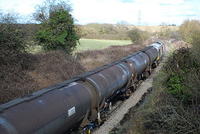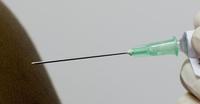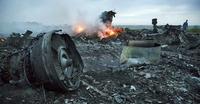-
West Virginia mulls releasing crude oil shipment information to the public

In May 2014, the U.S. Department of Transportation(DOT) ordered railroads operating trains carrying more than one million gallons of Bakken crude oil to notify state emergency officials in states through which oil-carrying trains travel of the expected movement of such trains. The order came to allow first responders to be better prepared should an accident occur. CSX Corporation agreed to share shipping information with West Virginia officials, but refused to release the information to the public citing concerns about terrorism. DOT made it clear that citing terrorism concerns does not exempt crude oil shipment information from being released to the public.
-
-
U.S. air marshal in quarantine after suspected Ebola syringe attack at Lagos airport

An American federal air marshal was placed in quarantine in Houston, Texas yesterday after being attacked Sunday night at the Lagos, Nigeria airport. The assailant wielded a syringe which contained an unknown substance, and was able to inject an unknown substance into the back of one of the air marshal’s arms. The marshal was able to board the United Airlines flight to Houston, where he was met by FBI agents and health workers from the Centers for Disease Control (CDC).
-
-
Atlanta’s rapid transit deploys AI video analytics to bolster public safety
The Metropolitan Atlanta Rapid Transit Authority (MARTA) is deploying Behavioral Recognition Systems’ AISight, an artificial intelligence-based analytics solution that teaches itself to recognize and alert on unexpected patterns within massive volumes of data.
-
-
Better security for Europe’s mass transportation
When a suspicious individual flees on a bus or by train, things usually get tough for the police. This is because the security systems of the various transportation companies and security services are typically incompatible. The EU project, Secur-ED (Secure Urban Mass Transportation – European Demonstrator), aims to correct this by establishing better collaboration among transportation companies within the same city.
-
-
Traceable fingerprints for freight items
Security is a top priority in air freight logistics, but screening procedures can be time consuming and costly. Researchers intend to boost efficiency with a new approach to digital logistics, without sacrificing the security of air freight operations. The researchers are working, among other things, on a marker that can be used to verify whether a freight item has already been X-rayed — something that has not been traceable. The researchers are additionally developing an RFID seal in order to detect subsequent tampering with a shipment.
-
-
Security flaws found in backscatter X-ray scanners
A team of researchers has discovered several security vulnerabilities in full-body backscatter X-ray scanners deployed to U.S. airports between 2009 and 2013. Secure 1000 scanners were removed from airports in 2013 due to privacy concerns, and are now being repurposed to jails, courthouses, and other government facilities. “The system’s designers seem to have assumed that attackers would not have access to a Secure 1000 to test and refine their attacks,” said one of the researchers. The researchers, however, were able to purchase a government-surplus machine found on eBay and subject it to laboratory testing.
-
-
Photo-ID security checks flawed: Study
Passport issuing officers are no better at identifying whether someone is holding a fake passport photo than the average person, new research has revealed. A pioneering study of Australian passport office staff revealed a 15 percent error rate in matching the person to the passport photo they were displaying. In real life this degree of inaccuracy would correspond to the admittance of several thousand travelers bearing fake passports.
-
-
U.S. to impose stricter safety rules on crude oil rail shipment
The U.S. Department of Transportation(DOT) recently announced proposed rulesbetter to secure train cars and pipelines from oil spills that may lead to fire or accidents in communities across the country. The spills are byproducts of the increase in U.S. oil production and shipments coming from Canada or the Bakken oil fields of North Dakota. The proposed DOT rules would force railroads to upgrade railroad cars used for transporting crude oil, employ better braking systems, and enforce tighter speed controls.
-
-
Airports scrambling to find effective passenger Ebola screening methods
Some airports in Africa have begun screening passengers for Ebola. The current methods involves thermal screening of patients, and then subjecting passengers with an elevated temperature, a symptom of Ebola, to a blood testcalled a polymerase chain reaction test. The test can take eight hours or longer to obtain lab results, and is expensive.Aviation experts recommend screening passengers for Ebola the same way aviation security screen passengers for other threats like terrorism, but say the screening methods must be made to yield results more quickly and cheaply.
-
-
New rules proposed for crude oil shipments
U.S Department of Transportation (DOT) secretary Anthony Foxx has announced that the department is proposing new rules for shipments of high-hazard crude oil by trains, as well as moving to phase out the use of older tank cars that many see as unsafe. The order follows a deadly year for oil train accidents, including a July 2013 derailment in Lac Megantic, Quebec resulting in the deaths of forty-seven people and a 30 April derailment in Lynchburg, Virginia.
-
-
100% scanning of U.S.-bound cargo containers delayed until 2016
DHS has delayed until 2016 the implementation of key sections of the SAFE Port Act of 2006, which requires that 100 percent of U.S.-bound ocean containers be scanned at the foreign port of origin. U.S. importers welcome the news of the delay, but they urge Congress to eliminate the scanning requirement altogether. Some observers note that the mandate, in any event, fails to make clear how DHS defines the word “scanned.”
-
-
Airports say TSA makes privatizing security screening a challenge
Airport officials described their challenges getting the Transportation Security Administration(TSA) to approve contractors, as part of the agency’s push to privatize more aviation security. The TSA was created to standardize and improve security after 9/11, but the agency’s Screening Partnership Programfor airports allows for private contractors, as long as security levels meet standards set by the TSA.
-
-
Backscatter body scanner making a comeback
Airline passengers have already said bon voyage to the controversial backscatter X-ray security scanners, pulled from U.S. airports in 2013 over concerns about privacy and potential radiation risks. The devices may, however, be reintroduced in the future, in part because they produce superior images of many concealed threats, and Congress still wants to know whether these systems — currently used in prisons, in diamond mines, and by the military — produce safe levels of radiation for screeners and the people they screen.
-
-
Renewed interest in defending civilian airlines raised by MH17 downing, Israel flight ban

The 48-hour ban on international flights to and from Ben Gurion International Airport in Israel was the result of a Hamas rocket landing in Yahud, a small town about a mile-and-a-half from the airport. The likelihood of a rocket fired from Gaza landing on the runways or terminal at Ben Gurion airport is small not only because of the inaccuracy of these rockets, but also because of the effectiveness of Iron Dome, Israel’s anti-rocket defense system. A much greater threat to civilian aviation is posed by surface-to-air missiles – either shoulder-mounted anti-aircraft missiles (or MANPADS, for man-portable air defense systems) or the much more powerful truck-mounted systems such as the SA-11, or BUK system, which Ukrainian separatists used to bring down flight MH17.
-
-
Airlines suspend international flights to and from Israel
With the downing by Ukrainian separatists of the MH17 jetliner as a backdrop, several international airlines on Tuesday have halted their flights to and from Israel. Some airlines said they would reconsider the decision after twenty-four hours, other airlines said the flights would be halted indefinitely. It appears that what triggered the decision was a Hamas rocket which landed in the town of Yahood, about a mile or two from Ben Gurion International Airport.
-
More headlines
The long view
New Technology is Keeping the Skies Safe
DHS S&T Baggage, Cargo, and People Screening (BCP) Program develops state-of-the-art screening solutions to help secure airspace, communities, and borders
